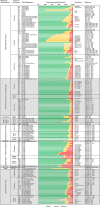The proportional distribution of training by elite endurance athletes at different intensities during different phases of the season
- PMID: 37964776
- PMCID: PMC10641476
- DOI: 10.3389/fspor.2023.1258585
The proportional distribution of training by elite endurance athletes at different intensities during different phases of the season
Abstract
The present review examines retrospective analyses of training intensity distribution (TID), i.e., the proportion of training at moderate (Zone 1, Z1), heavy (Z2) and severe (Z3) intensity by elite-to-world-class endurance athletes during different phases of the season. In addition, we discuss potential implications of our findings for research in this field, as well as for training by these athletes. Altogether, we included 175 TIDs, of which 120 quantified exercise intensity on the basis of heart rate and measured time-in-zone or employed variations of the session goal approach, with demarcation of zones of exercise intensity based on physiological parameters. Notably, 49% of the TIDs were single-case studies, predominantly concerning cross-country skiing and/or the biathlon. Eighty-nine TIDs were pyramidal (Z1 > Z2 > Z3), 65 polarized (Z1 > Z3 > Z2) and 8 "threshold" (Z2 > Z1 = Z3). However, these relative numbers varied between sports and the particular phases of the season. In 91% (n = 160) of the TIDs >60% of the endurance exercise was of low intensity. Regardless of the approach to quantification or phase of the season, cyclists and swimmers were found to perform a lower proportion of exercise in Z1 (<72%) and higher proportion in Z2 (>16%) than athletes involved in the triathlon, speed skating, rowing, running, cross-country skiing or biathlon (>80% in Z1 and <12% in Z2 in all these cases). For most of the athletes their proportion of heavy-to-severe exercise was higher during the period of competition than during the preparatory phase, although with considerable variability between sports. In conclusion, the existing literature in this area does not allow general conclusions to be drawn. The methods utilized for quantification vary widely and, moreover, contextual information concerning the mode of exercise, environmental conditions, and biomechanical aspects of the exercise is often lacking. Therefore, we recommend a more comprehensive approach in connection with future investigations on the TIDs of athletes involved in different endurance sports.
Keywords: HIIT (High intensity interval training); elite athlete; endurance; endurance training; exercise intensity; training intensity distribution.
© 2023 Sperlich, Matzka and Holmberg.
Conflict of interest statement
The authors declare that the research was conducted in the absence of any commercial or financial relationships that could be construed as a potential conflict of interest. The author(s) declared that they were an editorial board member of Frontiers, at the time of submission. This had no impact on the peer review process and the final decision.
Figures




References
-
- Johansen JM, Goleva-Fjellet S, Sunde A, Gjerlow LE, Skeimo LA, Freberg BI, et al. No change – no gain; the effect of age, sex, selected genes and training on physiological and performance adaptations in cross-country skiing. Front Physiol. (2020) 11:581339. 10.3389/fphys.2020.581339 - DOI - PMC - PubMed
Publication types
LinkOut - more resources
Full Text Sources

